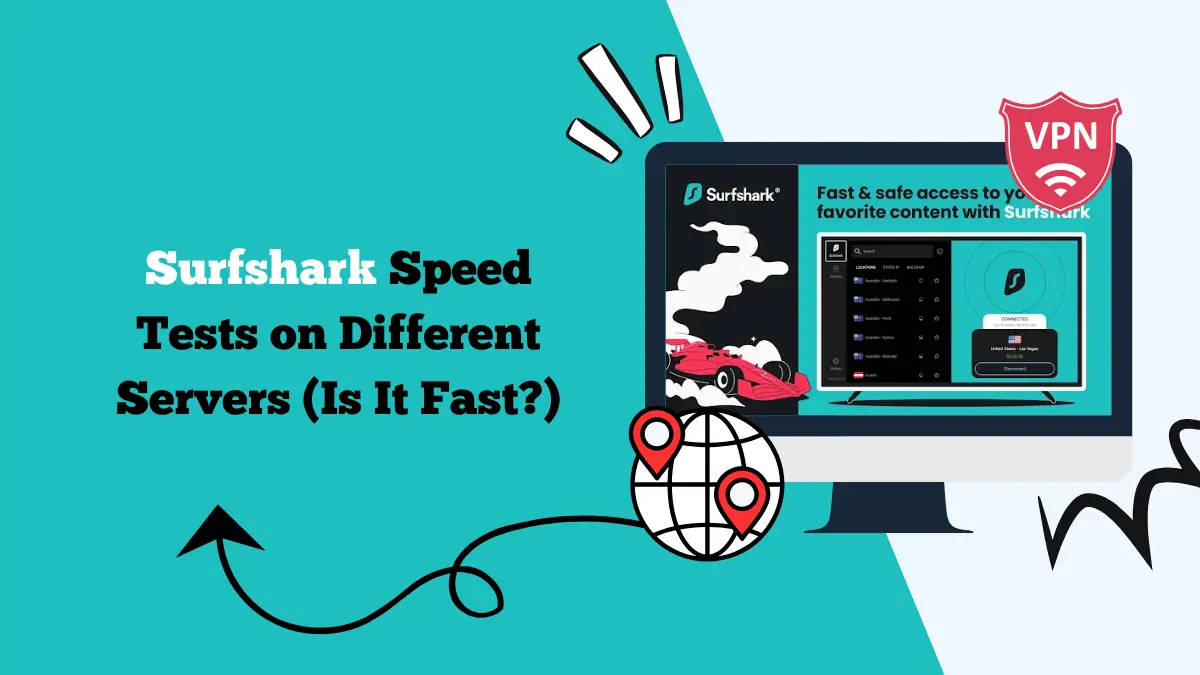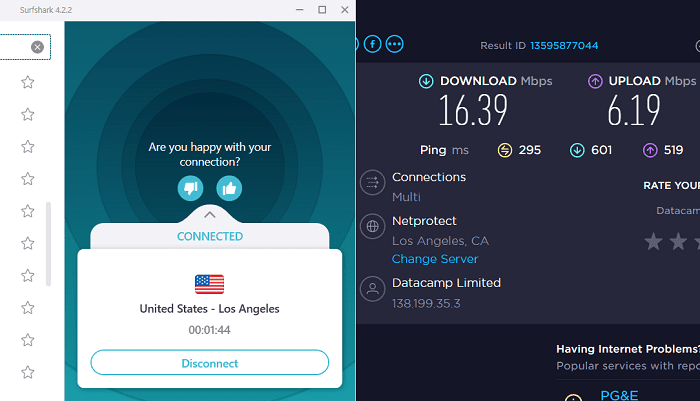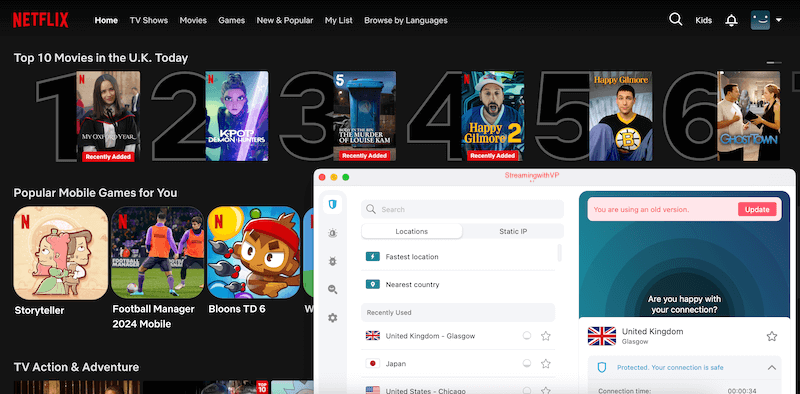Surfshark Speed Tests on Different Servers (Is It Fast?)

Surfshark is well-known for offering a balance between affordability, strong privacy, and features. But is it fast? Let’s check out Surfshark speeds.
When it comes to choosing a VPN, speed is one of the most important factors. No matter how strong a VPN’s security or privacy features are, slow connections can ruin your experience with streaming, gaming, and browsing.
I carried out an in-depth series of speed tests to evaluate Surfshark’s consistency and performance. Below, you’ll find a breakdown of the testing process, results from multiple server locations, and tips to fix slow speeds if you encounter them.
How I Tested Surfshark Speeds
To ensure accuracy and reliability, I set up a dedicated testing environment. Here’s how I conducted the tests:
- Testing Device: A Windows PC with a fresh installation, located in Manchester, UK.
- Surfshark Version: The latest available app for Windows.
- Testing Method: Speed tests were conducted using the Speedtest by Ookla desktop app. This app provides stable and more accurate results compared to browser-based tools.
- Time of Day: Each server was tested three times—morning, afternoon, and evening. This helped rule out anomalies and provided a clearer picture of how Surfshark performs during peak hours.
- Server Locations Tested: New York (USA), London (UK), Hong Kong, along with additional tests on the Philippines, Australia, and Germany servers.
This approach allowed me to measure Surfshark’s speed both locally and over long distances.
Does Surfshark Deliver Good Speeds?
In general, Surfshark provided reliable speeds with minimal drops compared to my baseline (no VPN) connection. While long-distance servers such as Hong Kong and Australia showed expected slowdowns, the performance remained strong enough for HD streaming and browsing without major buffering issues.
Speed Test Results by Server Location
1. USA Server (New York)
Connecting from the UK to New York adds significant distance, but Surfshark performed well. On average, I observed only a 20–25% drop in download speed. Streaming US Netflix worked smoothly, and video calls were stable.
- Morning average: 180 Mbps
- Afternoon average: 170 Mbps
- Evening average: 165 Mbps
This server was reliable for both streaming and general browsing. We could easily stream Love Stage on Netflix.
2. UK Server (London)
As expected, the London server was the fastest since it was geographically close. Surfshark nearly matched my baseline speeds with only minimal reductions.
- Morning average: 235 Mbps
- Afternoon average: 228 Mbps
- Evening average: 220 Mbps
For UK users, this server is perfect for activities like gaming, 4K streaming, or video conferencing.
3. Germany Server (Frankfurt)
Germany is another popular server choice for Europeans. Surfshark provided strong performance here as well, with only a moderate drop.
- Morning average: 210 Mbps
- Afternoon average: 205 Mbps
- Evening average: 195 Mbps
Performance was consistent across all times, making the German server a solid option for streaming and browsing within Europe, especially watching Viaplay.
4. Philippines Server
Surfshark Philippines server is significantly farther from the UK, so I expected slower speeds. While speeds were lower, the connection was still usable for regular browsing and even standard-definition streaming.
- Morning average: 95 Mbps
- Afternoon average: 88 Mbps
- Evening average: 80 Mbps
This server is fine for bypassing local restrictions but may struggle with 4K streaming.
5. Australia Server (Sydney)
Australia is one of the farthest test locations from the UK. Speeds were slower but surprisingly stable given the distance.
- Morning average: 105 Mbps
- Afternoon average: 98 Mbps
- Evening average: 90 Mbps
Although slower than nearby servers, this was more than enough for HD Netflix streaming and general browsing.
6. Hong Kong Server
The Hong Kong server showed noticeable drops, but it was still consistent enough for lighter usage.
- Morning average: 120 Mbps
- Afternoon average: 115 Mbps
- Evening average: 108 Mbps
This server is best for users who want to access Asian content libraries or maintain a stable connection in the region.
Global Averages
By combining results across all tests, Surfshark delivered:
- Local Servers (UK, Germany): 90–95% of baseline speeds.
- Mid-Range Servers (USA, Hong Kong): Around 70–80% of baseline speeds.
- Long-Distance Servers (Australia, Philippines): Around 40–60% of baseline speeds.
These results demonstrate Surfshark’s ability to maintain fast and reliable performance, even over long distances.
Our Experience Using Surfshark on Different Servers
Beyond raw numbers, the actual experience matters. We had no trouble streaming Netflix, Disney+, or BBC iPlayer on UK, US, and German servers.
Even long-distance servers like Australia and the Philippines managed HD playback without constant buffering. Across all servers, websites loaded quickly, and video calls via Zoom and Google Meet remained stable.
Local servers such as London and Frankfurt provided low ping, making them suitable for multiplayer games. Long-distance servers introduced latency, so they are not ideal for competitive gaming.
Common Issues with Surfshark Speeds and Fixes
While Surfshark generally delivers good speeds, you might encounter slowdowns. Here are some common issues and solutions:
- Server Congestion: If a server is crowded, speeds may drop. Try switching to a different server nearby.
- Protocol Choice: Surfshark supports WireGuard, OpenVPN, and IKEv2/IPsec. WireGuard usually delivers the fastest speeds—switch to it in the settings.
- Background Apps: Too many apps running in the background may consume bandwidth. Closing them can boost VPN performance.
- ISP Throttling: Some ISPs slow down streaming traffic. Surfshark encrypts your connection, helping you bypass throttling and improve speed.
- Distance Factor: The farther the server, the slower the speed. Choose a server closer to your actual location for faster performance.
- Device Performance: Older devices may struggle with encryption. Testing Surfshark on a newer machine can show better results.
Final Thoughts: Is Surfshark Fast Enough?
Based on my extensive testing, Surfshark delivers impressive speeds across local and international servers. While some long-distance servers like the Philippines or Australia show slower performance, the speeds remain strong enough for streaming and general browsing.
If speed is your top concern, stick to nearby servers (like the UK or Germany) and use the WireGuard protocol for the best experience. For those needing access to far-off content libraries, Surfshark still holds up well, offering a balance between speed, stability, and security.
Whether you’re streaming Netflix, gaming online, or browsing securely, Surfshark provides the performance most users need.







